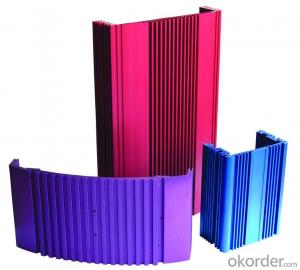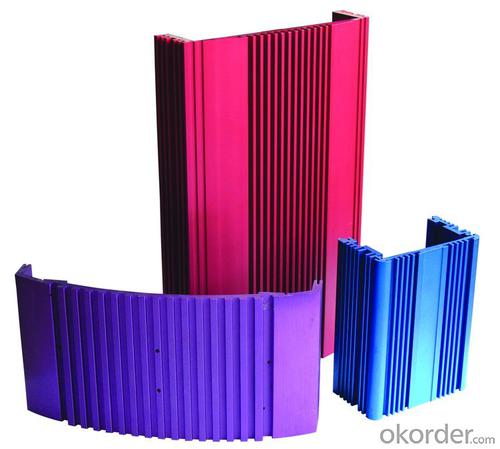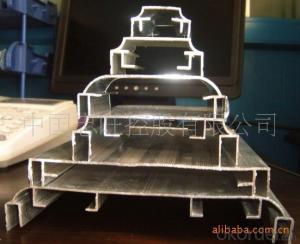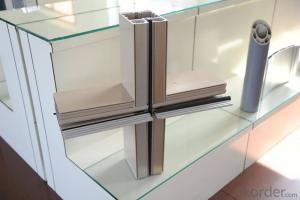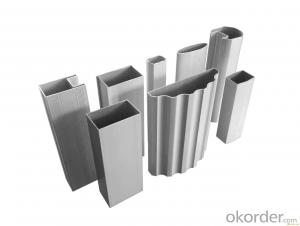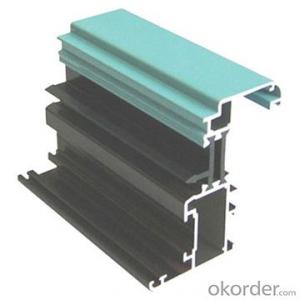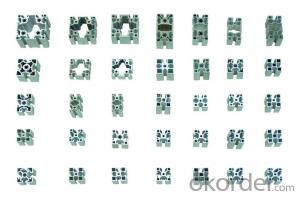Aluminum Extrusion Profiles for Doors and Windows Canada
- Loading Port:
- China Main Port
- Payment Terms:
- TT OR LC
- Min Order Qty:
- -
- Supply Capability:
- -
OKorder Service Pledge
OKorder Financial Service
You Might Also Like
Quick Details
| Place of Origin: | Brand Name: | Model Number: | |||
| Open Style: | Surface Finishing: | Type: | |||
| Sliding Door Type: | Door Material: | material: |
Packaging & Delivery
| Packaging Detail: | IN CARTON |
| Delivery Detail: | IN 15 DAYS |
Specifications
1)Usages:windows,doors,curtainwalls,solar panel
2)Material:Aluminum Alloy
3)Certificate:CE,ISO9001
Mould | Based on your drawings or use our moule |
| Profile shape | We can design and provide different shape according market order |
| Features | Subtle edges and elegant appearance andeasy processing and installation |
| Fabrication | windows,doors,cutting,drilling |
| Applications | doora/windows,equipment frame and industrial usage |
Goldsword Aluminum Factory | |
Business Type | Aluminium windows and doors profile |
Product series | aluminium windows and doors profile |
Price Determination | Based on Aluminum Ingot Price + Process fee |
Payment Term | T/T, L/C at sight |
Surface Treatment | We can provide aluminum profiles with mill finish, powder coating, anodizing, polishing, sand blasting, electrophoresis and wood color. |
Color | We can provide white, wood color, black, golden, blue, champagne, and other colors as required. |
Packing | Composite paper, Plastic paper, other packing method required by customers is available. 2 to 20 pcs per bundle, sometimes small profiles are plugged in big ones so as to save space for customers. |
Product specification | 1. Alloy: 6063-T5/T6 2. Length: 3-6.5 m 3. Normal anodizing thickness: 8 to 12 micro 4. Normal powder coating thickness: 60 – 100 micro 5. Tensile Strength: ≥160 MPa 6. Yield strength: ≥110 MPa 7. Extensibility: ≥8% 8. Hardness (HW): ≥8 |
1).materies:aluminium alloy
2)grade:6000 series
3)temper:T3-T8
4)certificate:CE,ISO9001:2008
- Q: What does "T" in the aluminum profile 6063-T5 mean?
- China's current general is the United States Aluminum Association "Aluminium Association" numberT5By cooling the high temperature molding process, and then the artificial aging state. Applied by cooling high temperature molding process, not through the cold processing (for straightening and leveling, but does not affect the mechanical properties of the limit), to artificial aging products.
- Q: This question asks if aluminum profiles can be used in outdoor settings and seeks an explanation for their suitability.
- <p>Yes, aluminum profiles can be used for outdoor applications. They are suitable for outdoor use due to their high resistance to corrosion, which is a result of the natural oxide layer that forms on aluminum when exposed to air. This layer protects the aluminum from further oxidation and damage. Additionally, aluminum profiles are lightweight, strong, and can withstand various weather conditions, making them ideal for applications such as outdoor furniture, construction, and signage. Their durability and low maintenance requirements also contribute to their popularity in outdoor settings.</p>
- Q: Are aluminum profiles suitable for use in automotive suspension systems?
- Yes, aluminum profiles are suitable for use in automotive suspension systems. Aluminum is a lightweight and strong material that offers several advantages in suspension design. Firstly, the lightweight nature of aluminum profiles helps to reduce the overall weight of the suspension system. This not only improves fuel efficiency but also enhances the performance and handling of the vehicle. The reduced weight allows for quicker acceleration, better braking, and improved maneuverability. Secondly, aluminum profiles have excellent strength-to-weight ratio, meaning they can withstand high loads and stresses while still being lightweight. This makes them ideal for handling the dynamic loads experienced by suspension systems, such as bumps, vibrations, and impacts. Aluminum profiles can effectively absorb and distribute these loads, providing a smooth and comfortable ride for the occupants of the vehicle. Additionally, aluminum is resistant to corrosion, which is a critical factor in automotive applications. The suspension system is exposed to various environmental conditions, including moisture, salt, and road debris. By using aluminum profiles, the risk of corrosion is minimized, leading to increased durability and longevity of the suspension components. Furthermore, aluminum profiles are highly versatile and can be easily shaped and formed into complex geometries required for suspension system components. This allows for greater design flexibility and optimization of performance. Aluminum profiles can be used to manufacture various suspension components, including control arms, knuckles, and subframes. In conclusion, aluminum profiles are indeed suitable for use in automotive suspension systems. Their lightweight, high strength-to-weight ratio, corrosion resistance, and design flexibility make them an excellent choice for optimizing the performance, efficiency, and durability of suspension systems in vehicles.
- Q: Are aluminum profiles suitable for mass production or large-scale projects?
- Yes, aluminum profiles are highly suitable for mass production and large-scale projects. Aluminum is a lightweight and versatile material that offers excellent strength and durability. Its malleability allows for easy customization and fabrication, making it ideal for creating complex shapes and designs. Additionally, aluminum profiles have excellent corrosion resistance, ensuring longevity in various environmental conditions. Moreover, aluminum is recyclable, making it a sustainable choice for large-scale projects. Therefore, aluminum profiles are a preferred choice for industries such as construction, automotive, aerospace, and manufacturing, where mass production and large-scale projects are common.
- Q: Aluminum extrusion die, what material is better? Can reach long life, extruded products surface smooth and smooth?
- Agree with the upstairs view, the surface of the product is smooth or not, and extrusion process has a lot to do with the flatness of the work belt
- Q: What are the different extrusion methods used for aluminum profiles?
- There are several different extrusion methods used for aluminum profiles, including direct extrusion, indirect extrusion, impact extrusion, and hydrostatic extrusion. Each method has its own advantages and is suited for specific applications. Direct extrusion involves pushing the aluminum billet through a die to create the desired shape, while indirect extrusion involves the billet being held stationary and the die moving towards it. Impact extrusion involves forcing the aluminum into a die cavity using a high-velocity impact, and hydrostatic extrusion uses high-pressure fluid to push the aluminum through the die.
- Q: How is the tonnage of aluminum profile extrusion machine calculated? Do you have any formulas? For example, 30*60 industrial profiles, the need for a large tonnage of extrusion machine can be done?
- This depends on the section of the rice weight, the length of the required material, as well as extrusion deformation of the profile to consider, but generally to 6 meters out of the standard length, and then according to meters to determine the machine
- Q: How do aluminum profiles perform in terms of sound insulation?
- Compared to materials like wood or uPVC, aluminum profiles generally do not have good sound insulation properties. This is because aluminum is lightweight and thin, allowing sound waves to easily pass through. Furthermore, aluminum profiles often have a hollow structure, which further reduces their ability to block or absorb sound. It is important to consider that the overall sound insulation performance of a window or door system depends on various factors. These include the thickness of the glass, the quality of the seals, and the installation method. To improve the sound insulation capabilities of aluminum profiles, manufacturers may incorporate additional features such as double or triple glazing, laminated glass, or acoustic seals. In conclusion, while aluminum profiles alone may not offer optimal sound insulation, their performance can be enhanced by combining them with other elements. If sound insulation is a major concern, it is advisable to explore alternative materials that inherently provide better sound insulation properties.
- Q: What are the different packaging and shipping considerations for aluminum profiles?
- Some different packaging and shipping considerations for aluminum profiles include ensuring proper protection against scratches and dents during transportation, using suitable packaging materials such as foam or bubble wrap, securing the profiles to prevent movement or shifting, labeling packages with handling instructions, and selecting appropriate shipping methods to minimize the risk of damage.
- Q: What are the benefits of using aluminum profiles in interior design?
- Aluminum profiles offer numerous advantages when incorporated into interior design. To begin, their versatility allows for a wide range of applications. They can be easily customized and fabricated to meet various design requirements, whether it be for a modern or traditional interior. This flexibility makes aluminum profiles an ideal solution. Furthermore, despite their lightweight nature, aluminum profiles are remarkably durable. They resist corrosion, moisture, and temperature changes, ensuring a long lifespan. This durability also translates into minimal maintenance, saving time and money in the long term. Another benefit lies in the aesthetic appeal of aluminum profiles. With various finishes, colors, and textures available, designers can achieve their desired look and feel. Aluminum profiles can be anodized, powder-coated, or polished, resulting in a sleek and contemporary appearance. Additionally, they can mimic other materials like wood or stainless steel while retaining the advantages aluminum offers. Moreover, aluminum profiles possess excellent thermal and acoustic insulation properties. They regulate temperature and reduce noise levels, creating a more comfortable and serene environment. This proves especially advantageous in spaces where soundproofing or energy efficiency is essential, such as offices, hotels, or residential areas. Lastly, aluminum profiles contribute to eco-friendliness and sustainability. Aluminum is highly recyclable, and incorporating it into interior design helps reduce waste and minimize environmental impact. Furthermore, these profiles enhance energy efficiency by allowing natural light to enter a space, minimizing the need for artificial lighting during daylight hours. In conclusion, the advantages of aluminum profiles in interior design encompass versatility, durability, aesthetic appeal, thermal and acoustic insulation, and sustainability. These qualities make aluminum profiles a favored choice for designers and architects seeking to create functional and visually captivating spaces.
Send your message to us
Aluminum Extrusion Profiles for Doors and Windows Canada
- Loading Port:
- China Main Port
- Payment Terms:
- TT OR LC
- Min Order Qty:
- -
- Supply Capability:
- -
OKorder Service Pledge
OKorder Financial Service
Similar products
Hot products
Hot Searches
Related keywords
